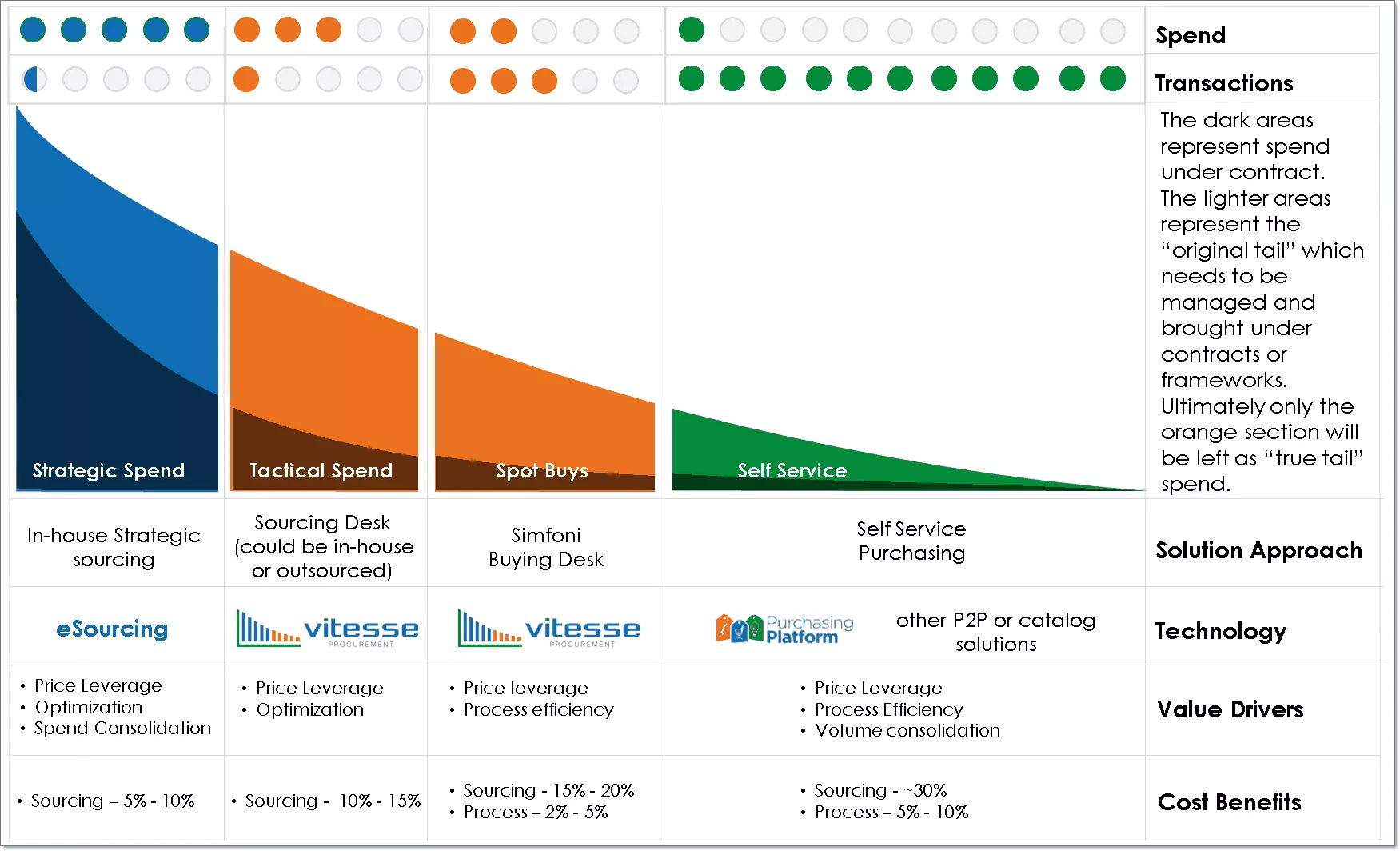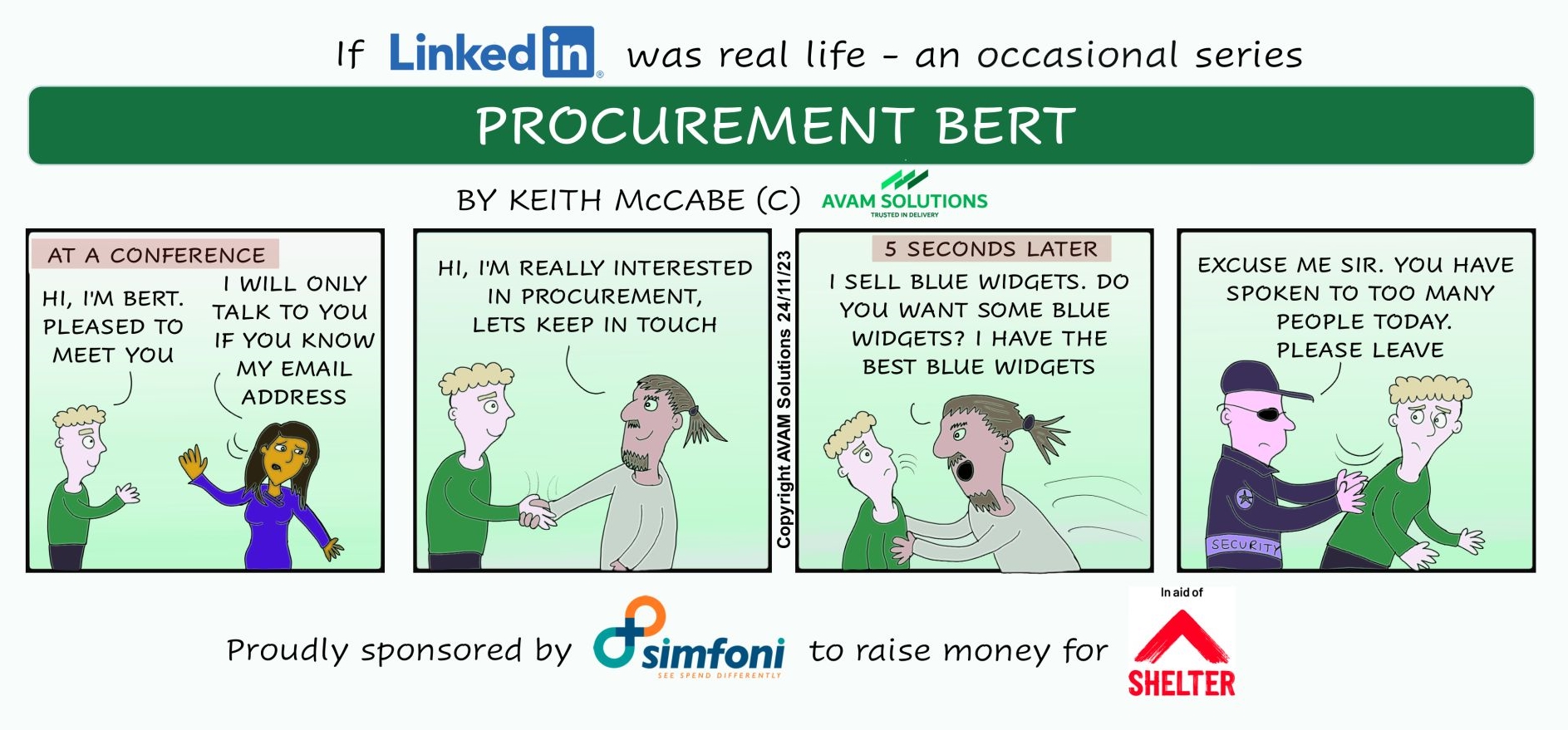Tail spend is the 20% of spend that typically goes unmanaged within an organization. It is not actively managed in all the spend categories and may have an impact on the firm’s financial performance.
At a headline level, I think most procurement folks are now familiar with the concept of tail spend: the low-value spend items that are non-core but still essential to the smooth operation of an organization. And of course, as the segment matures, even the tail itself comes under greater scrutiny or micro-segmentation with expressions such as tip of the tail, tail of the tail, mid-tail, tactical spends, spot buys, catalog buys, guided buying, “precision buying” (Simfoni’s own attempt to join the party!) and so on.
So what exactly are we talking about in terms of the items that fall under all these different expressions? In this article I’d like to offer a simple model that describes the types of spend that reside within the tail spend category, and propose the optimum technique for how best to address each one.

1. Petty Cash/Expense Items:
At the bottom end of the “spend” chain are the day-to-day expenses that need to be made “mostly out of the office.” Lunches, taxis, fuel, sundry items mostly related to travel or urgent “in the field” expenses, like a replacement power cable for the one you left on the plane! In smaller organizations it may include the travel itself, although larger firms use travel management companies to book flights, car rental, etc. — and consequently travel is managed as a category in its own right and is not part of tail spend.
Read More – How does Tail Spend Analytics work
If you don’t include the travel itself, these expenses constitute less than 1% of 1% of an organization’s expenditure and also don’t consume a huge amount of time in processing costs because the approval process is replaced by a trust system (i.e., you really did have the lunch with a work-related person) and payment processes are devolved (i.e., you buy the item yourself so no corporate involvement in the financing). The key emphasis for spend management is on supervising the trust system — having the ability to ensure the expenditure is genuinely made for business purposes, and only appropriate expenditures are being consumed. The best way to address such expenses is through the use of P-cards for your “big” spenders and mobile expense apps for everyone else. There are plenty of options for both products in the market. The best ones allow notification of expenses above a certain value and classification of expenditure by category to facilitate review and benchmarking; why does John spend more on meals than Frank when they do the same job? Mobile expense apps should also include expense capture by smartphone camera, or email submission, approval of expenses and ideally integrate with major finance systems enabling the reimbursement of expenses at the push of a button.
2. E-marketplace Spend
The next step up the chain takes us to what I call “marketplace spending.” This comprises the most basic, most frequently purchased items that are common to all organizations. Office paper and pens, batteries, power tools, paper cups, laptops, “no smoking” signs, desktop fans, even tables and chairs all represent such standard, repeatable purchases. Organizations buy them all the time, they really don’t care that much about getting absolutely the best price because these items are not of material value. They typically represent around 5-10% of a typical company’s total third-party spend. But on the other hand, they do represent about 90% of a company’s transactions so the speed and effort of transaction is far more important. This is the area where companies are trying to avoid the “tragedy of the $15 pencil” — an item whose price is only $1 but incurs $14 of staff time to approve and pay for the purchase.
Read More: – What is Source to Pay – A Guide to Source to Pay (S2P) Process
As you can guess from the title, the channel to use for this stuff is an e-marketplace. Yes, they add a small mark-up into the price to make their money, but this is far outweighed by the savings that they derive from group purchasing power and the time saved by your staff trying to find the right products themselves or through a complicated e-procurement catalog architecture. Honestly, even if you buy billions of dollars of this stuff, in this day and age, the marketplaces out there are sophisticated enough to handle special/additional discounts for larger customers as well as the typical customizations, such as corporate catalog functions where you can shortlist items to limit the choice for your users, add your own approval workflows and budgeting functions. There’s no hassle from managing catalog content, keeping items and prices updated — not to mention the software fees for a catalog management system.
Read More:- How Important is Catalog Procurement in the Management of Tail Spend?

3. Custom Catalogs
OK, here’s where things can get a tiny bit confusing. If you are a manufacturing business, then you may buy a heck of a lot of power tools; and in this case, your shopfloor folks will care very much about which power tools they have access to, and they’ll know the total cost of ownership of a Makita vs. a Black & Decker better than the back of their hand. So there are items for which your business requirement is very specific; tools are an obvious one, marketing promotional items could also be and so on. Some businesses may not have any custom catalog spend at all, but it can be as much as 15% in certain circumstances.
For items like this, it would make sense for an organization to have its own framework agreements with their preferred vendors, maintaining the full range required by the organization while de-listing the unrequired items. And of course what better way to make such purchases available to staff than through an online catalog. But, please challenge yourself on this: It really is one of those “less is more” type situations. Note that even more than 20 years since its availability, adoption of online procurement is pitifully low — below 10% according to Forrester — and while there are several reasons for this, providing users with 30-odd catalogs to access (often with overlapping products if you are not careful) simply creates confusion and definitely contributes to adoption apathy.
Read More:- What is Procure to Pay – A Guide to Procure-to-Pay (P2P) Process
4. Tactical Buys
The next type of spend up the chain are spot buys; but the difference between spot buys and tactical buys are more easily explained by defining tactical buys and then distinguishing how spot buys are different!
So, tactical buying represents those items that mostly are known to the user. That is to say, the item has been purchased before, and the vendor or vendor base is known. They differ from custom catalog spend in that the frequency of purchase is much lower and hence does not warrant the investment in a particular framework agreement. Examples could include the purchase of mechanical handling equipment, fork lift batteries, and my current favorite from a customer we are working with in motor racing industry: flower decorations for pit lane — go figure! Tactical buys typically represent around 15-25% of an organization’s spend, and individual orders tend to be in the $5,000-$250,000 range.
Since the spend levels have jumped up, we have now migrated into the land of requisitioning, sourcing and tail spend management. The goods or services typically have a specification but the specification might change periodically, as might the volume requirement. So last year’s flower decorations might have been white roses whereas this year the theme might be red tulips. The key from a channel management perspective is to easily identify the preferred vendors for this group, while maintaining some competitive tension in the pricing since the spend can amount to a significant level. Since the user typically knows quite well what they are buying, the emphasis is on rapid turnaround and competitive pricing. The tool being used should allow the user (or buyer) to automatically add the historical vendors for the item and potentially offer recommendations of other appropriate vendors if so desired. It should automate as much as possible the translation of the requisition into an RFQ and use the legacy information about vendors to manage the quotation process. The expression “guided buying” has come into common parlance to describe tools that successfully undertake such activities.
Read More:- Why Mid-Size Companies Need On-Demand Solutions to Conquer Tail Spend
5. Spot Buys
In aggregate, spot buys are lower in value than tactical buys on operational expenditure (around 10-15%), but if you include capital expenditures, they can amount to very big numbers — potentially more than the entire value of the rest of the tail, where large CapEx projects are being undertaken.
Spot buys are one-off purchases. And as such, the user has limited product knowledge and limited supply base knowledge. My favorite current example is full body scanners — the sort of thing you walk through at in airport security. Increasingly we see organizations investing in such devices at the entrance to buildings. For the poor individual tasked with such a purchase, it is almost certainly the first time he ever bought such a product, but the task is a minefield of potential traps. For a start, prices range from $5,000 to over $100,000, and if you are buying five of them (one for each entrance or location in your business) then it really matters that you don’t overpay. Equally it also matters that you buy something fit for the purpose that doesn’t fall apart after six months, has the appropriate after-care etc. You’re pretty much guaranteed to be fired if you overpay or under spec.
Most users undertake such procurement activity using the same tools and processes as tactical buying — in each case tailoring their exact process by type of category and value of spend, a process that we call triage. At Simfoni, we have pioneered the concept of Precision Buying™. Using artificial intelligence and machine learning, we have amassed a repository of attributes or characteristics of products based on the millions of products and services that we have bought in the past. We start with a predictive text application that helps the user find the commonly used term for a particular item; for example if a user types “X-ray machine” the system will prompt them with various options, of which full body scanner would be one. Then with Precision Buying™ when a user selects the description “full body scanner,” our tool immediately presents them with the key attributes against which you would determine what type of scanner to buy: Size, Weight, Scanning Speed, Duty Cycle, X-ray dose, Resolution, Detectability, etc. And within each attribute, a selection of variables. The end users or buyers are able to make selections with much greater confidence. Finally based on the selected description, our system is able to offer up appropriate vendors from a database of over 250,000 TAIL SPEND vendors that have been built up over time. The savings from avoiding over specification of items can be as much as 40-50%, as you can imagine from the scanner example.
Simfoni’s Vitesse™ Tail Spend platform combines all the above tools (expense app, marketplace, custom catalogs, guided buying and Precision Buying™) within a single, easy-to-use application available on an on-demand basis with no upfront license or maintenance fees.













